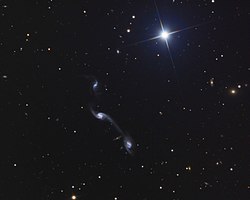Arp 248
| Galaxie Arp 248 | |
|---|---|
 | |
| AladinLite | |
| Sternbild | Jungfrau |
| Position Äquinoktium: J2000.0, Epoche: J2000.0 | |
| Rektaszension | 11h 46m 42,6s[1] |
| Deklination | -03° 50′ 28″[1] |
| Erscheinungsbild | |
| Helligkeit (visuell) | 13,3 mag[1] |
| Winkelausdehnung | 4,2′ × 2′ |
| Physikalische Daten | |
| Rotverschiebung | 0,017600 ± 0,000025[1] |
| Radialgeschwindigkeit | (5276 ± 7) km/s[1] |
| Hubbledistanz vrad / H0 | (230 ± 16) · 106 Lj (70,6 ± 4,9) Mpc [1] |
| Geschichte | |
| Katalogbezeichnungen | |
| PGC 36723/36733/36742 • MCG -01-30-32/33/34 • Arp 248 • VV 35 • | |
Arp 248, auch als Wilds Triplett bezeichnet, ist ein interagierendes Galaxientriplett im Sternbild Jungfrau auf der Ekliptik. Sie ist schätzungsweise 230 Mio. Lichtjahre von der Milchstraße entfernt. Halton Arp gliederte seinen Katalog ungewöhnlicher Galaxien nach rein morphologischen Kriterien in Gruppen. Diese Galaxie gehört zu der Klasse Galaxien mit Anzeichen für eine Aufspaltung.
- (c) Credit: ESA/Hubble & NASA, Dark Energy Survey/DOE/FNAL/DECam/CTIO/NOIRLab/NSF/AURA, J. Dalcanton, CC BY 4.0
Hochaufgelöste Aufnahme zweier Galaxien von Arp 248, erstellt mithilfe des Hubble-Weltraumteleskops und des Victor M. Blanco Telescope
Weblinks
Literatur
- Jeff Kanipe und Dennis Webb: The Arp Atlas of Peculiar Galaxies – A Chronicle and Observer´s Guide, Richmond 2006, ISBN 978-0-943396-76-7
Einzelnachweise
Auf dieser Seite verwendete Medien
Autor/Urheber: Credit Line and Copyright Adam Block/Mount Lemmon SkyCenter/University of Arizona, Lizenz: CC BY-SA 3.0 us
Wild's Triplet of Interacting Galaxies
Picture Details:
Optics 24-inch RC Optical Systems Telescope Camera SBIG STL11000 CCD Camera Filters Custom Scientific Dates February 1st 2009 Location Mount Lemmon SkyCenter Exposure LRGB = 150:30:30:40 minutes Acquisition ACP Observatory Control Software (DC-3 Dreams),TheSky (Software Bisque), Maxim DL/CCD (Cyanogen) Processing CCDStack (CCDWare), Mira (MiraMetrics), Maxim DL (Cyanogen), Photoshop CS3 (Adobe)Credit Line and Copyright Adam Block/Mount Lemmon SkyCenter/University of Arizona
(c) Credit: ESA/Hubble & NASA, Dark Energy Survey/DOE/FNAL/DECam/CTIO/NOIRLab/NSF/AURA, J. Dalcanton, CC BY 4.0
Hubble Inspects A Pair of Space Oddities
This image from the NASA/ESA Hubble Space Telescope shows two of the galaxies in the galactic triplet Arp 248 — also known as Wild's Triplet — which lies around 200 million light-years from Earth in the constellation Virgo. The two large spiral galaxies visible in this image — which flank a smaller, unrelated background spiral galaxy — seem to be connected by a luminous bridge. This elongated stream of stars and interstellar dust is known as a tidal tail, and it was formed by the mutual gravitational attraction of the two foreground galaxies.
This observation comes from a project which delves into two rogues’ galleries of weird and wonderful galaxies: A Catalogue Of Southern Peculiar Galaxies And Associations, compiled by astronomers Halton Arp and Barry Madore, and the Atlas of Peculiar Galaxies, compiled by Halton Arp. Each collection contains a menagerie of spectacularly peculiar galaxies, including interacting galaxies such as Arp 248, as well as one- or three-armed spiral galaxies, galaxies with shell-like structures, and a variety of other space oddities.
Hubble used its Advanced Camera for Surveys to scour this menagerie of eccentric galaxies in search of promising candidates for future observations with the NASA/ESA/CSA James Webb Space Telescope, the Atacama Large Millimeter/submillimeter Array, and Hubble itself. With such a wealth of astronomical objects to study in the night sky, projects such as this, which guide future observations, are a valuable investment of observing time. As well as the scientific merits of observing these weird and wonderful galaxies, they were also — very unusually — selected as Hubble targets because of their visual appeal to the general public!
[Image description: Two spiral galaxies are viewed almost face-on; they are a mix of pale blue and yellow in colour, crossed by strands of dark red dust. They lie in the upper-left and lower-right corners. A long, faint streak of pale blue joins them, extending from an arm of one galaxy and crossing the field diagonally. A small spiral galaxy, orange in colour, is visible edge-on, left of the lower galaxy.]
Credit:
ESA/Hubble & NASA, Dark Energy Survey/DOE/FNAL/DECam/CTIO/NOIRLab/NSF/AURA, J. Dalcanton
Coordinates Position (RA): 11 46 40.80 Position (Dec): -3° 51' 9.14" Field of view: 3.02 x 3.34 arcminutes Orientation: North is 33.3° right of vertical
Colours & filters Band Wavelength Telescope Optical G 474 nm Víctor M. Blanco 4-meter Telescope DECam Optical R 644 nm Víctor M. Blanco 4-meter Telescope DECam Optical Z 919 nm Víctor M. Blanco 4-meter Telescope DECam Optical V 606 nm Hubble Space Telescope ACS.





